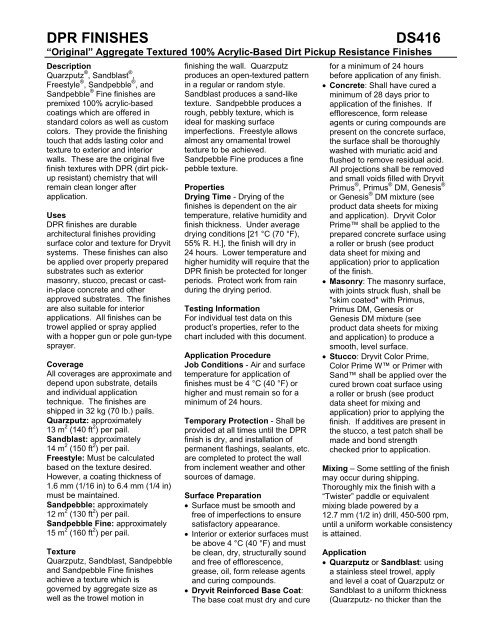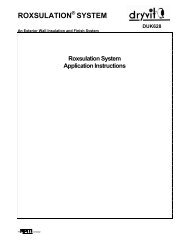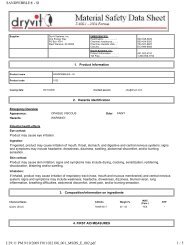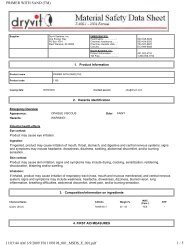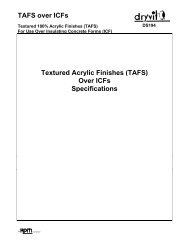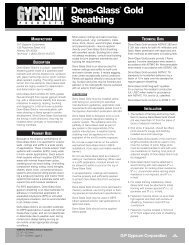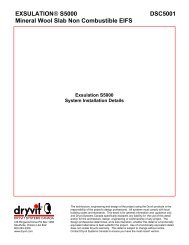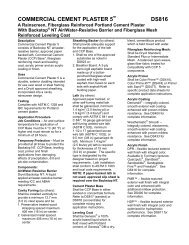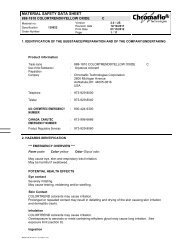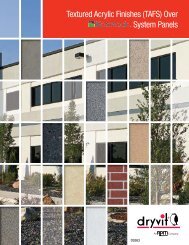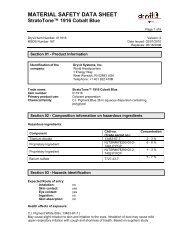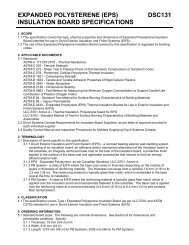DS416 - DPR Finishes Data Sheet - Continuous Insulation - Dryvit
DS416 - DPR Finishes Data Sheet - Continuous Insulation - Dryvit
DS416 - DPR Finishes Data Sheet - Continuous Insulation - Dryvit
Create successful ePaper yourself
Turn your PDF publications into a flip-book with our unique Google optimized e-Paper software.
<strong>DPR</strong> FINISHES <strong>DS416</strong><br />
“Original” Aggregate Textured 100% Acrylic-Based Dirt Pickup Resistance <strong>Finishes</strong><br />
Description<br />
Quarzputz ® , Sandblast ® ,<br />
Freestyle ® , Sandpebble ® , and<br />
Sandpebble ® Fine finishes are<br />
premixed 100% acrylic-based<br />
coatings which are offered in<br />
standard colors as well as custom<br />
colors. They provide the finishing<br />
touch that adds lasting color and<br />
texture to exterior and interior<br />
walls. These are the original five<br />
finish textures with <strong>DPR</strong> (dirt pickup<br />
resistant) chemistry that will<br />
remain clean longer after<br />
application.<br />
Uses<br />
<strong>DPR</strong> finishes are durable<br />
architectural finishes providing<br />
surface color and texture for <strong>Dryvit</strong><br />
systems. These finishes can also<br />
be applied over properly prepared<br />
substrates such as exterior<br />
masonry, stucco, precast or castin-place<br />
concrete and other<br />
approved substrates. The finishes<br />
are also suitable for interior<br />
applications. All finishes can be<br />
trowel applied or spray applied<br />
with a hopper gun or pole gun-type<br />
sprayer.<br />
Coverage<br />
All coverages are approximate and<br />
depend upon substrate, details<br />
and individual application<br />
technique. The finishes are<br />
shipped in 32 kg (70 lb.) pails.<br />
Quarzputz: approximately<br />
13 m 2 (140 ft 2 ) per pail.<br />
Sandblast: approximately<br />
14 m 2 (150 ft 2 ) per pail.<br />
Freestyle: Must be calculated<br />
based on the texture desired.<br />
However, a coating thickness of<br />
1.6 mm (1/16 in) to 6.4 mm (1/4 in)<br />
must be maintained.<br />
Sandpebble: approximately<br />
12 m 2 (130 ft 2 ) per pail.<br />
Sandpebble Fine: approximately<br />
15 m 2 (160 ft 2 ) per pail.<br />
Texture<br />
Quarzputz, Sandblast, Sandpebble<br />
and Sandpebble Fine finishes<br />
achieve a texture which is<br />
governed by aggregate size as<br />
well as the trowel motion in<br />
finishing the wall. Quarzputz<br />
produces an open-textured pattern<br />
in a regular or random style.<br />
Sandblast produces a sand-like<br />
texture. Sandpebble produces a<br />
rough, pebbly texture, which is<br />
ideal for masking surface<br />
imperfections. Freestyle allows<br />
almost any ornamental trowel<br />
texture to be achieved.<br />
Sandpebble Fine produces a fine<br />
pebble texture.<br />
Properties<br />
Drying Time - Drying of the<br />
finishes is dependent on the air<br />
temperature, relative humidity and<br />
finish thickness. Under average<br />
drying conditions [21 °C (70 °F),<br />
55% R. H.], the finish will dry in<br />
24 hours. Lower temperature and<br />
higher humidity will require that the<br />
<strong>DPR</strong> finish be protected for longer<br />
periods. Protect work from rain<br />
during the drying period.<br />
Testing Information<br />
For individual test data on this<br />
product’s properties, refer to the<br />
chart included with this document.<br />
Application Procedure<br />
Job Conditions - Air and surface<br />
temperature for application of<br />
finishes must be 4 °C (40 °F) or<br />
higher and must remain so for a<br />
minimum of 24 hours.<br />
Temporary Protection - Shall be<br />
provided at all times until the <strong>DPR</strong><br />
finish is dry, and installation of<br />
permanent flashings, sealants, etc.<br />
are completed to protect the wall<br />
from inclement weather and other<br />
sources of damage.<br />
Surface Preparation<br />
Surface must be smooth and<br />
free of imperfections to ensure<br />
satisfactory appearance.<br />
Interior or exterior surfaces must<br />
be above 4 °C (40 °F) and must<br />
be clean, dry, structurally sound<br />
and free of efflorescence,<br />
grease, oil, form release agents<br />
and curing compounds.<br />
<strong>Dryvit</strong> Reinforced Base Coat:<br />
The base coat must dry and cure<br />
for a minimum of 24 hours<br />
before application of any finish.<br />
Concrete: Shall have cured a<br />
minimum of 28 days prior to<br />
application of the finishes. If<br />
efflorescence, form release<br />
agents or curing compounds are<br />
present on the concrete surface,<br />
the surface shall be thoroughly<br />
washed with muriatic acid and<br />
flushed to remove residual acid.<br />
All projections shall be removed<br />
and small voids filled with <strong>Dryvit</strong><br />
Primus ® , Primus ® DM, Genesis ®<br />
or Genesis ® DM mixture (see<br />
product data sheets for mixing<br />
and application). <strong>Dryvit</strong> Color<br />
Prime shall be applied to the<br />
prepared concrete surface using<br />
a roller or brush (see product<br />
data sheet for mixing and<br />
application) prior to application<br />
of the finish.<br />
Masonry: The masonry surface,<br />
with joints struck flush, shall be<br />
"skim coated" with Primus,<br />
Primus DM, Genesis or<br />
Genesis DM mixture (see<br />
product data sheets for mixing<br />
and application) to produce a<br />
smooth, level surface.<br />
Stucco: <strong>Dryvit</strong> Color Prime,<br />
Color Prime W or Primer with<br />
Sand shall be applied over the<br />
cured brown coat surface using<br />
a roller or brush (see product<br />
data sheet for mixing and<br />
application) prior to applying the<br />
finish. If additives are present in<br />
the stucco, a test patch shall be<br />
made and bond strength<br />
checked prior to application.<br />
Mixing – Some settling of the finish<br />
may occur during shipping.<br />
Thoroughly mix the finish with a<br />
“Twister” paddle or equivalent<br />
mixing blade powered by a<br />
12.7 mm (1/2 in) drill, 450-500 rpm,<br />
until a uniform workable consistency<br />
is attained.<br />
Application<br />
Quarzputz or Sandblast: using<br />
a stainless steel trowel, apply<br />
and level a coat of Quarzputz or<br />
Sandblast to a uniform thickness<br />
(Quarzputz- no thicker than the
<strong>DPR</strong> <strong>Finishes</strong> <strong>DS416</strong><br />
largest aggregate; Sandblast -<br />
applied in a thickness of<br />
1.2 mm (3/64 in) – approximately<br />
1 1/2 times the largest<br />
aggregate). The textures are<br />
achieved by uniform hand<br />
motion and/or type of tool used.<br />
Maintain wet edge for uniformity<br />
of color and texture.<br />
Sandpebble or Sandpebble<br />
Fine: roughly apply an even coat<br />
of finish to a thickness slightly<br />
thicker than the largest<br />
aggregate size. Then pull<br />
across the rough application<br />
coat using a horizontal trowel<br />
motion and develop a uniform<br />
thickness no greater than the<br />
largest aggregate of the material.<br />
The textures are achieved by<br />
uniform hand motion and/or type<br />
of tool used. Maintain wet edge<br />
for uniformity of color and<br />
texture.<br />
Freestyle: using a stainless<br />
steel trowel, apply a coat of the<br />
Freestyle slightly thicker than<br />
1.6 mm (1/16 in). The texture is<br />
either pulled out of this base or<br />
achieved by adding more<br />
Freestyle finish to the base layer<br />
using the same texturing motions<br />
that are used with other plaster<br />
materials, such as a skip trowel<br />
finish. The thickness of any<br />
Freestyle finish texture shall not<br />
exceed 6.4 mm (1/4 in).<br />
Clean Up - Clean tools with water<br />
while the finishes are still wet.<br />
Maintenance - All <strong>Dryvit</strong> products<br />
are designed to require minimal<br />
maintenance. However, as with all<br />
building products, depending on<br />
location, some cleaning may be<br />
required. See <strong>Dryvit</strong> publication<br />
DS152 on cleaning and recoating.<br />
Storage<br />
<strong>Finishes</strong> must be stored at a<br />
minimum of 4 °C (40 °F) and a<br />
maximum of 38 °C (100 °F) in<br />
tightly sealed containers out of<br />
direct sunlight.<br />
Cautions and Limitations<br />
<strong>Dryvit</strong> finishes must not be used<br />
on exposed exterior horizontal<br />
surfaces. Minimum slope is<br />
2<br />
6 in 12 which is 27°. Maximum<br />
length of slope is 305 mm (12 in).<br />
<strong>Dryvit</strong> finishes shall not be used<br />
below grade when applied as the<br />
finish for an EIF System.<br />
<strong>Dryvit</strong> finishes are not intended<br />
for direct-applied, vertical<br />
applications over exterior type<br />
gypsum based sheathing board,<br />
foam plastic insulation or other<br />
type insulation board.<br />
<strong>Dryvit</strong> finishes shall not be<br />
returned into any sealant joint.<br />
Instead, a coat of <strong>Dryvit</strong> Color<br />
Prime or <strong>Dryvit</strong> Demandit ®<br />
should be applied over the base<br />
coat in the joint.<br />
Minimize exposure of materials<br />
to temperatures over 32 °C<br />
(90 °F).<br />
<strong>Finishes</strong> exposed to<br />
temperatures over 43 °C<br />
(110 °F) for even short periods<br />
may exhibit skinning, increased<br />
viscosity, and should be<br />
inspected prior to use<br />
Technical and Field Services<br />
Available on request.
<strong>DPR</strong> <strong>Finishes</strong> <strong>DS416</strong><br />
Test Test Method<br />
<strong>DPR</strong> Finish Testing<br />
Criteria Results 1<br />
Surface Burning<br />
ASTM E 84 ICC and ANSI/EIMA 99-A-2001 Passed<br />
Characteristics<br />
Flame Spread


